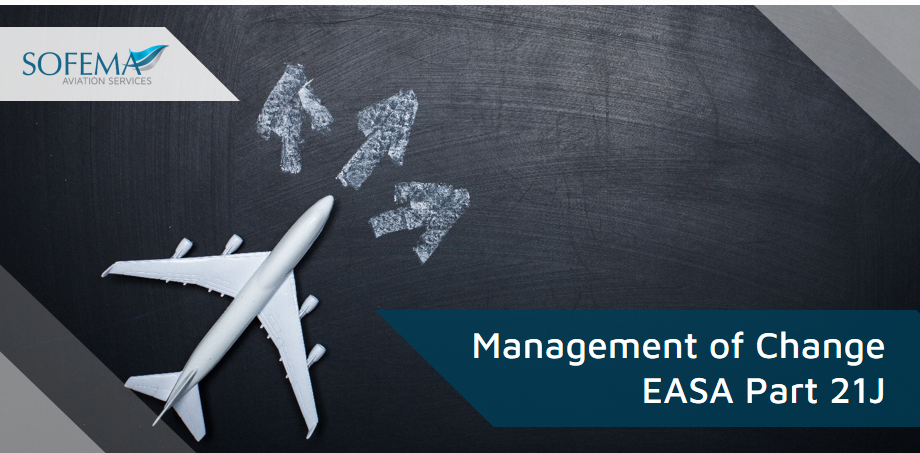Sofema Aviation Services (SAS) www.sassofia.com considers the process of engagement with the management of change requirements as well as the impact on existing processes and issues of concern.
Introduction
Engaging with the Management of Change as part of Part 21J SMS obligations requires a structured, proactive approach that considers the full lifecycle of the change, from identification and assessment through to implementation, monitoring, and continuous improvement. By effectively managing changes, Part 21J organizations can ensure that safety remains a top priority, even as they evolve and adapt to new challenges and opportunities.
Management of Change (MoC) is a crucial component of Safety Management Systems (SMS), especially within the context of EASA Part 21J organizations.
- Engaging with MoC effectively requires a structured approach that addresses both the regulatory obligations and the practical implications for the organization’s existing processes.
Understanding the Need for Management of Change
- MoC is essential in ensuring that any changes within an organization—be it operational, organizational, technological, or related to personnel—are assessed and managed in a way that maintains or enhances safety.
- Changes can significantly impact product safety and compliance with regulatory standards for Part 21J organizations involved in the design and production of aircraft and aviation components.
Steps to Engage with Management of Change in Part 21J SMS
- Identify Changes Requiring Management:
o Not all changes will have a significant impact on safety. It’s crucial to identify which changes are substantial enough to warrant a full Management of Change process.
o This includes changes in design processes, manufacturing methods, critical suppliers, or organizational structure.
Risk Assessment of Proposed Changes
- Before implementing any change, conduct a thorough risk assessment to understand its potential impact on safety.
o This should consider both direct impacts (e.g., on product safety) and indirect impacts (e.g., on quality control processes).
Develop and Implement Mitigation Strategies
- Based on the risk assessment, develop strategies to mitigate any identified risks to an acceptable level.
o This may involve revising design specifications, updating training programs, or enhancing quality controls.
Consultation and Communication:
- Engaging with stakeholders, including employees, suppliers, and regulatory authorities, is critical.
o Effective communication ensures that all parties understand the nature of the change, the reasons for it, and their roles in implementing it successfully.
Documentation and Record Keeping
- Maintain comprehensive documentation of the Management of Change process.
o This should include the rationale for the change, the risk assessment process, mitigation measures, and any communications with stakeholders.
o Documentation is crucial for regulatory compliance and for future reference.
Training and Competency
- Ensure that all affected personnel receive appropriate training on the changes being implemented. This is vital for maintaining safety and operational effectiveness.
Monitoring and Evaluation
- After implementing a change, continuously monitor its impact to ensure that safety objectives are being met and that no unforeseen risks have emerged.
Impact on Existing Processes and Issues of Concern
Integration with Existing SMS: Management of Change must be seamlessly integrated with the organization’s existing SMS.
- This can be challenging if the existing SMS is not sufficiently flexible or if there is resistance to change within the organization.
- Significant changes may require substantial resources, including time, personnel, and financial investment. Balancing these demands with ongoing operations can be challenging.
- Organizational inertia and resistance from employees accustomed to existing processes can hinder the effective implementation of changes. Overcoming this requires strong leadership and clear communication about the benefits of the change.
- Ensure that changes comply with all relevant EASA regulations and standards.
- Changes can impact the organization’s safety culture, either positively by enhancing safety awareness and practices or negatively by introducing uncertainty or reducing adherence to safety protocols.
o Monitoring and managing the impact on safety culture is crucial.
Next Steps
Follow this link to our Library to find & download related documents for Free.
Sofema Aviation Services (www.sassofia.com) and Sofema Online (www.sofemaonline.com) provide classroom, Webinar and Online training to support EASA Part 21 J Design Organisation Training & Development – For comments or questions, please email team@sassofia.com
Tags:
aviation, aviation safety, EASA, Risk Assessment, Documentation, Aviation Safety Management System, SAS blogs, Aviation Safety Managemen, Management of Change, Management of Change (MOC), engagement, Communications, mitigation strategies, EASA Part 21J





